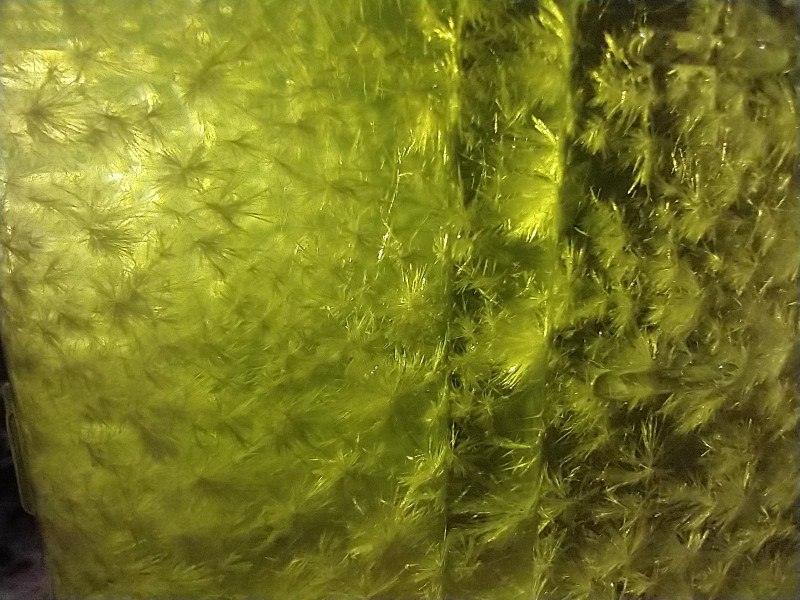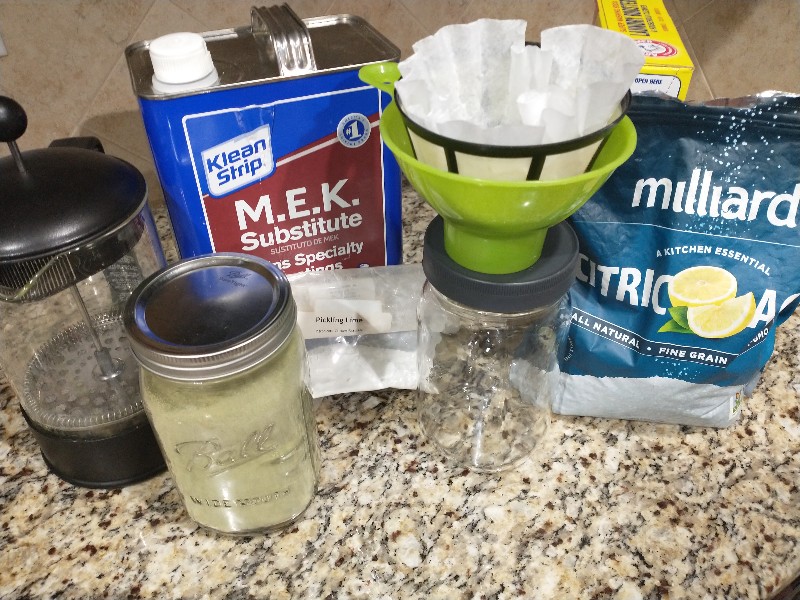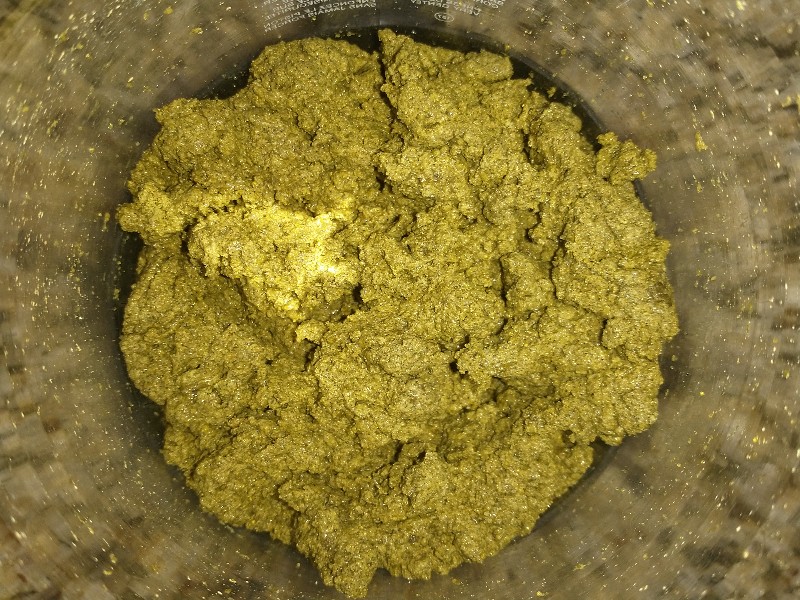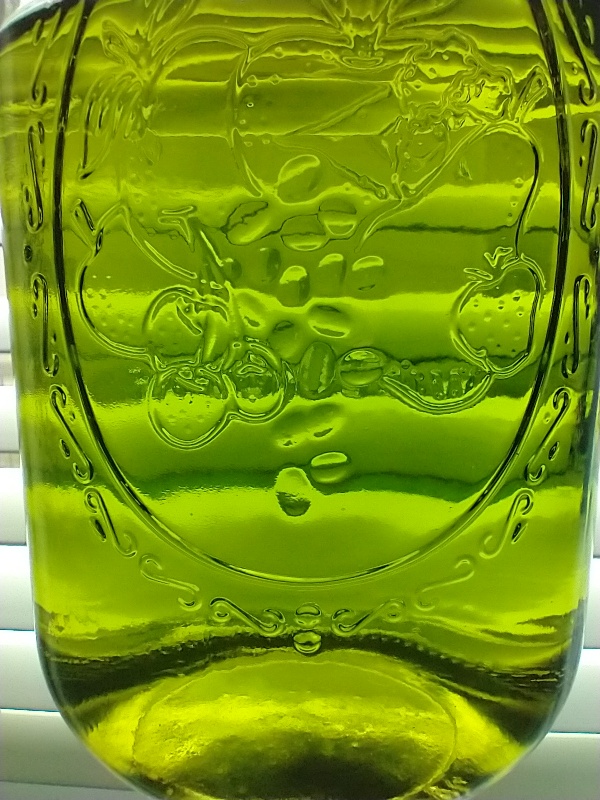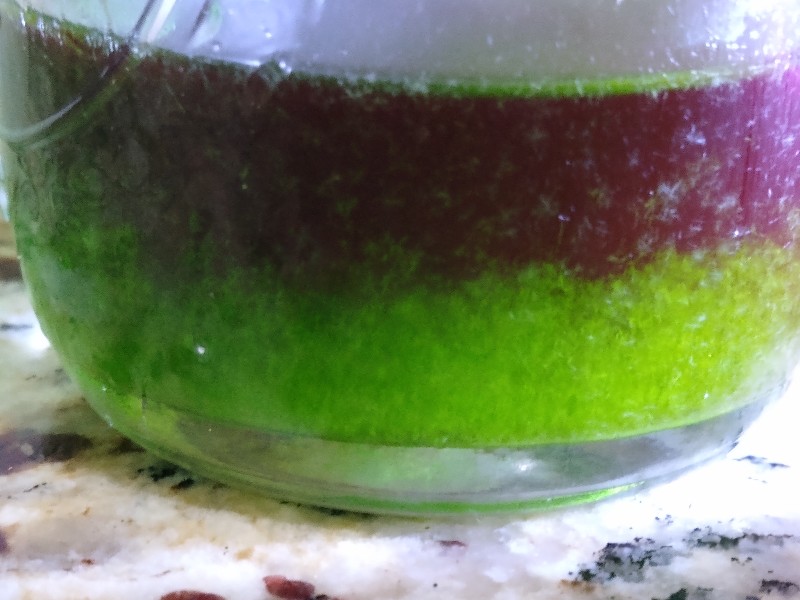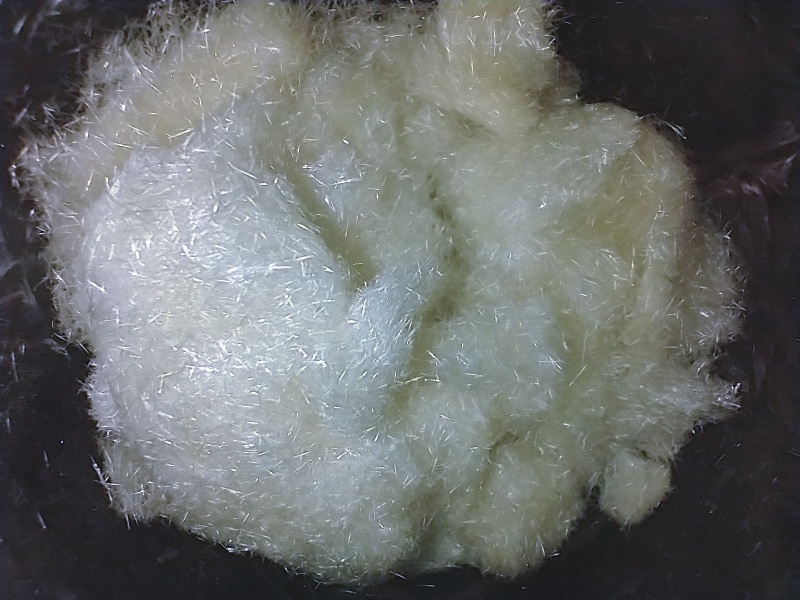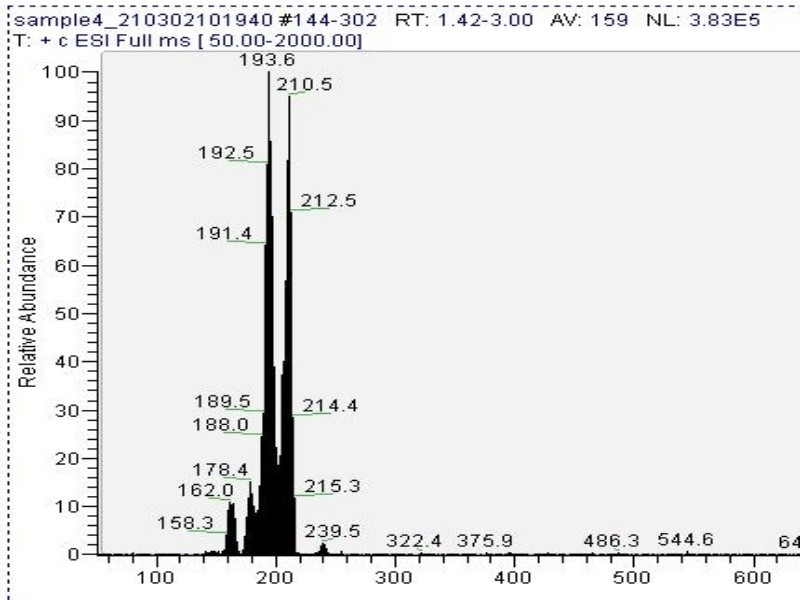CIELO
Contents
Introduction 🙏
CIELO stands for Crystals In Ethyl-acetate Laizily Over-the-counter. In this process, mescaline from cactus is precipitated in ethyl acetate as monomescaline citrate crystals (see Fig. 1). This technique (TEK) is specialized for catus, simple, and avoids harsh chemicals.
Thanks to everyone who contributed to this process: someblackguy, benzyme, shroombee, Metta-Morpheus, Downwardsfromzero, Kash, grollum, Mindlusion, Doubledog, Dreamer042, merkin, _Trip_, Cheelin, Highlightprotein, Loveall, and others.
Safety ⛑️
Review ethyl acetate[1] and citric acid[2] safety information. Verify solvent MSDS, plastic compatibility, and clean evaporation.
This TEK is food safe if food grade materials are used.
Following this advice does not guarantee safety. It is up to each adult individual to make their own personal decisions.
Materials🛒
Consumables👩🌾
- 100g cactus powder
- 25g Ca(OH)2 (lime)
- 300g water
- 1qt ethyl acetate (sometimes sold as "MEK substitute")
- 2.5g of citric acid (roughly 1/2 tsp)
Equipment🏺
- French press (optional)
- Coffee filters, support basket, and funnel
- Mason jars
- Kitchen scale
Process Overview 👀
In short:🌵➠🟢➠🧑🏾🔬➠✨➠💖➠💚, where,
- 🌵: Grind dry cactus to a fine powder
- 🟢: Mix cactus powder to a wet alkaline cactus paste
- 🧑🏾🔬:Pull alkaline cactus paste with ethyl acetate
- ✨: Precipitate mescaline from ethyl acetate with citric acid
- 💖: Collect and wash monomescaline citrate crystals
- 💚: Store ethyl acetate for reuse
Detailed Process 📜
Powder 🌵
Grow[3] and harvest cactus. Store cuttings in a dark place for at least 3 months (e.g. in a paper bag or wrapped in newspaper). Data shows dark storage increases mescaline content[4]. Chop whole cacti into ~half inch slices and completely dry them with a food dehydrator (any temperature) or oven at low temp (~175C).
All parts of the cactus can be used. Outer green skin yields seven times more than the inner white core for the same dry mass[5]. Outer waxy layers and spines do not yield product, they can optionally be removed but are not detrimental to the extraction.
Grind dry catus to a fine powder. This can be done in two steps, first through a food processor and then through a coffee grinder.
It is very important to make a uniform cactus powder that is dry (<10% moisture) and finely ground. Clouds of fine dust fly into the air when handling a good powder, reminiscent of flour (but green colored). Old cactus powder may change to a tan color and also works well in this process.
Paste 🟢
Make milky water in a french press, quart jar, or mixing bowl by adding lime to water. Mix so there are no lumps of lime. Without giving lime time to settle, gradually add the cactus powder, stirring thoroughly to ensure the cactus is well incorporated into the milky water (8-10 minutes). The last ~25% of the cactus powder volume will be easiest to incorporate by a combination of stirring and mashing. The paste will have a fluffy, smooth texture. In case of doubt, mix more. Let sit for at least 10 more minutes.
This paste has the same ratios originally used in 69ron's limonene TEK [6]. It is very important to mix the paste well and obtain the proper texture. Some elbow grease is required, so mix with intent.
Boiling water option: Combine the cactus powder and lime. Add ~300ml of boiling water and mix very well for at least 10 minutes. Cover and rest overnight. The paste will congeal after cooling. Immediately before extracting, mix in ~25ml of boiling water to loosen up the paste to a consistency similar to mashed potatoes (see Fig. 3).
Extract 🧑🏾🔬
If available, the paste should be in a French press. The French press will make it easy to decant the ethyl acetate. Optionally the paste can be in a a quart jar, but it's not as easy to decant the ethyl acetate. It is possible to have the paste in a mixing bowl, but decanting may be cumbersome.
Cover paste with ethyl acetate (~200g) and stir gently for 45-60 seconds. You do not need to stir aggressively as ethyl acetate is very efficient at pulling freebase mescaline from the plant material. Aggressive stirring may cause the plant material to absorb more of the solvent. The ideal paste with becomes sandy during extraction and is very easy to handle but other textures also work. After stirring, allow to rest for 2 minutes, then decant into quart jar filtering through a coffee filter to catch unwanted plant material. If using a french press, gently squeeze to accelerate decanting while keeping plastic parts away from the solvent. After squeezing, the compacted paste can be stirred loose for a few seconds to release a small amount of solvent and squeezed again (repeat as needed to thoroughly complete pull).
If the paste absorbs all or most of the ethyl acetate during the first pull, that's fine. Just add more ethyl acetate, stir, rest, and decant as explained above. Do NOT add water or aggressively manipulate the paste in an attempt to force out the ethyl acetate. Some solvent absorption during the first pull is common. Even with some solvent stuck in the paste, you will still recover the vast majority of mescaline during subsequent pulls as ethyl acetate is not absorbed in subsequent pulls.
Repeat the extraction with ~125g of ethyl acetate until the extraction jar is full (5-6 total pulls). A small yield boost can be done by doing another 3 or more pulls into a second jar. This second jar is also a good check on the effectiveness of the pulls in the main jar the first time this TEK is performed.
All of the extraction pulls should be completed within 30 minutes. After 30 minutes the paste can begin to congeal, making solvent penetration and recovery more difficult. There is plenty of time to leisurely perform five to six 3-minute pulls by remaining focused on the task.
Rest the combined extract for at least an hour and then inspect for droplets or particles. If present, allow extract to rest until no more debris form and remove them. If using the boiling water option, rest extract in the fridge overnight and decant/filter a white precipitate that may appear. The extract needs to be clean in order for the crystallization process to happen reliably (see Fig. 4). To be sure extract is clean, one extra pass through a fresh coffee filter after settling is recommended.
Crystalize ✨
Dissolve ~2.5 grams (~1/2 teaspoon) of citric acid into extract (clouds should form), and let it rest. Crystals of monomescaline citrate should begin to appear after a few hours. Crystals can have different shapes and can stick to the wall (sometimes looking transparent and difficult to see). After the solution clears, allow crystalization to complete (~up to 72 hours).
Fast crystalization option: Drop 15 grams of citric acid into extract. Use a magnetic stirrer or aggressive shaking to quickly dissolve the citric acid and speed up crystallization. This produces a fast crystalization and minimizes crystals that are stuck to the wall. A stirring vortex will go from visible, to not visible as clouds form, to visible again as mescaline citrate precipitates. Crystals will be smaller with this approach and look like a powder, but the vast majority of them will still be caught by a filter in the next step. As with the previous option, allow crystalization to complete undisturbed (~72 hours).
Collect 💖
Swirl ethyl acetate to knock crystals loose. Crystals that cling to the wall can sometimes be dislodged with a knife or spoon. Send solvent trough a double coffee filter to catch loose crystals. Rinse any crystals remaining on jar walls with fresh ethyl acetate and send wash through filter to also wash the crystals there and collect any new crystals that are dislodged (repeat ~2-3x until off color is mostly removed). Collect crystals stuck on the jar walls (if any) by dissolving them in warm water, evaporating in a shallow dish, and scraping up dry crystals. Sometimes, the wall crystals form a transparent layer difficult to see. Combine with the collected crystals from the filter to obtain the final product (Fig. 6).
Yield depends on the cactus and is usually between 0.2% to 2% with ~1.2% being common[7]. The precise ratio of mescaline and citrate in the precipitate is not known and is under investigation (see development notes below). The monomescaline citrate salt, (MesH)H2Cit, is ~62% as strong as MesHCl by weight and consistent with the salt form (MesH)H2Cit. Approximate oral dosage recommendations for MesHCl[8] converted to monomescaline citrate (aka mescaline dihydrogen citrate):
Oral dosage for (MesH)H2Cit, aka monomescaline citrate, aka mescaline dihydrogen citrate:
- Threshold 80-160 mg
- Light 160 - 320 mg
- Common 320 - 520 mg
- Strong 520 - 1290 mg
- Heavy 1290 mg+
Mass spectrometry (MS) results from solaris analytical[9] indicate the product is very clean mescaline (Fig. 7).
Reuse 💚
Reusing solvents is encouraged[10] at the DMT nexus.
Used solvent from the boiling water paste is recommended for reuse. The room temperature paste loads the solvent with chlorophyll, making it darker and possibly more difficult to reuse.
Wash spent extract with sodium carbonate saturated water (35% by weight). About 1/5 of the solvent volume as saturated water is enough. Shake vigorously (emulsions do not form). CO2 bubbles may be visible during citric acid neutralization. Keep an eye on any bubbles and release any pressure buildup regularly. Neutralization can be optionally verified with pH paper. Filter any excess sodium carbonate/citrate and remove the water layer.
Frequently Asked Questions ❓
Q: Why does the TEK have so many options. I feel like I'm choosing my own adventure!
A: The options exist to try to make the TEK more robust. However, it has been argued that no options are needed, and crystals reliably form with good technique without having to add any options to the main TEK [11].
Q: Does increasing the basing time increase the yield?
A: No. Shroombee has tested 15 minute, 24 hour, and 72 hour basing times and there was no difference in yield. Other process variables were 8 minutes incorporating milky water with cactus, 6x3 minute pulls, and 15 mg/gram citric acid added with the fast crystallization method. Loveall has confirmed in his experiments that 10 minute and 24 hour basing times produce the same yield. So we assume that any basing time from 10 minutes through 72 hours will produce the same yield. See a detailed explanation in this post.[12]
Q: What’s the difference between the two crystalization methods?
A: In general, adding more citric acid and aggressively stirring or shaking will:
- Force crystals to form faster
- Form smaller and denser crystals less likely to stick to the jar walls
- Cause a negligible amount of tiny crystals to drop through the coffee filter.
Q: What is the upper limit of citric acid that can be added to the extract?
A: The solubility of citric acid in ethyl acetate is over 50 mg per gram of ethyl acetate. Note that plant matter or other unwanted extraction products may affect the solubility. Stay well under 50 mg/gram to ensure no undissolved citric acid is mixed in with the mescaline citrate.
Q: After adding citric acid, I saw clouds followed by precipitation, but the precipitate reminds me of citric acid. How do I know a mescaline salt is precipitating and not citric acid?
A: Citric acid does not precipitate and stays in solution because it is well bellow its solubility limit (50mg/g) in the TEK. The white particles that form from the clouds are salts and not citric acid. A thorough swirl may be needed at the end to make sure all the added citric acid has dissolved. Once it has dissolved it will not come out of solution as citric acid.
Q: After adding citric acid, I saw clouds but didn't get any solid precipitation, what gives?
A: First make sure the TEK instructions were followed, in particular: well mixed paste, short pull times, clean extract free of debris, citric acid is in range, etc. Before adding citric acid, allow the extract to rest. If it has excess water, drops will form on the jar walls and/or bottom that need to be decanted. If nothing is precipitating, bring up the citric acid concentration up to 20mg/g and wait a few days. Check the jar walls, a transparent product may have precipitated there (e.g. this has been reported for whole bridgessi[13]). Making the paste with boiling water and colder pulls with ethyl acetate chilled down to 0F grow larger crystals and should be easier to precipitate because they contain less plant material. If all else fails, pulling the extract with water, evaporating, and washing with fresh ethyl acetate should leave behind a potent residue (dose will be less accurate and can be made proportional to starting cactus amount).
Appendix: Development Notes 🔬
Paste 🌵
No improvements were seen with longer basing time, paste oven drying, or increasing the ionic strength with CaCl2. Microwave treatment resulted in a small yield loss.
Paste made with sodium carbonate saturated water congeals over time and requires long solvent soaks which are darker and don't crystallize to large loose crystals (small sticky crystals were obtained).
Use of lime and boiling water causes the saponification of chlorophyll over time [14]:
Chlorophyll is soluble in Ethyl Acetate, but Chlorophyllin and Phytol are not[15]. Saponification in hot water gives an extract with less plant matter and lighter color. It is assumed a priori to be easier to reuse.
Extract 👨🏾🔬
Tests with longer/warmer pulls resulted in darker extract, smaller crystals, solvent paste absorption, congealing of paste, and no yield benefit.
Chemically drying the extract with anhydrous CaCl2 had no benefits, while drying with MgSO4 was problematic. However, depending on the worker and techniques used, a chemical dry with CaCl2 pellets (available commercially as de-icer) could reduce water content in the solvent and possibly make crystallization easier. Washing soda (when sold as Na2CO3 in monohydrate form, or when making the anhydrous form from baking soda with an oven) may also dry the extract and be beneficial in such cases (but that is currently an assumption based on other lab techniques).
Crystalize ✨
During crystallization, excess citric acid (H3Cit) reacts with free base mescaline (Mes) to form to form the monomescaline citrate salt (MesH)H2Cit:
Monomescaline citrate salt's strength relative to mescaline HCl is 62% (ignoring any hydrate formation)[16]. By not using excess citric acid, different salt forms can be precipitated[17], but that process is more complex than the simpler excess citric acid approach.
There is a lot room for excess citric acid in solution since its solubility is 50mg/g in ethyl acetate. In extracts with crystallization issues, adding more citric acid can help force precipitation: in one example with whole cactus powder 20mg/g was used [18].
Several factors can make crystals smaller: Reusing ethyl acetate, longer/warmer pulls, higher citric acid concentration, mechanical agitation, and other potential variables. Small crystals can look like a fine powder. Potency does not seem affected by the crystallization appearance, and a powdery precipitate is not a problem unless it becomes difficult to decant/filter.
After the initial crystallization, adding more citric acid and/or moving the extract to the refrigerator does not result in any more precipitation. Moving the extract to the freezer produced ice crystals.
Other dry organic acids could work. Malic was tested but did not work as well as citric[19]. Fumaric, Tartaric, Ascorbic, Succinic, etc can be tested in future investigations.
10% sulfuric acid was tested and while some crystals formed, a separate liquid layer also appeared making the process not practical. HCl has not been tested as it may break down ethyl acetate.
Collect 💖
Washing crystals in a filter appears to wick away plant colors and is superior to decanting if the goal is white xtals.
The washed crystals in the filter can be dissolved in warm water along with any wall crystals. This will give then final product a uniform appearance with large needles forming during slow water evaporation.
References 🗝️
- ↑ Ethyl acetate safety[1]
- ↑ Citric Acid Safety[2]
- ↑ Cactus growing guide[3]
- ↑ Dark storage data[4]
- ↑ Result for different cactus parts[5]
- ↑ 69ron's Limonene TEK[6]
- ↑ Cactus analysis thread[7]
- ↑ Mescaline Oral Dosage[8]
- ↑ Solaris analytical service[9]
- ↑ On reusing non polar solvent[10]
- ↑ Cheeling's argument [11]
- ↑ Basing time tests results[12]
- ↑ Whole bridgessi precipitate on jar walls [13]
- ↑ Hot water saponification with lime[14]
- ↑ Phytol not present in Ethyl Acetate plant extract[15]
- ↑ Mescaline citrate vs HCl[16]
- ↑ Trimescaline citrate candidate[17]
- ↑ Ethyl acetate approach[18]
- ↑ Malic acid test[19]
